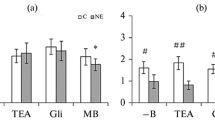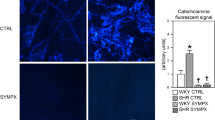Summary
Regional hemodynamic responses to the vasodilators, hydralazine (1mg/kg, i.v.) and verapamil (0.1 mg/kg/min, i.v.), were examined in conscious Wistar Kyoto rats (WKY) and spontaneously hypertensive rats (SHR), 15 and 50 weeks of age, using the radioactive microsphere method. The flow rates of heart and skeletal muscle in SHR were higher than those in WKY, and the flow rates of liver, kidney, intestines, and skin in SHR were lower than those in WKY. These differences between the regional blood flow in WKY and SHR were observed in both aged and young rats. The changes in organ blood flow induced by hydralazine and verapamil were similar for WKY and SHR in most organs. Both drugs increased the skeletal muscle blood flow in WKY and young SHR, but not in aged SHR, that is, the skeletal muscle blood vessels in aged SHR lost their vasodilatory response. These results suggest that, although a lack of vasodilatory responses in the skeletal muscle vasculature of aged SHR may be triggered by persistent hypertension, the vital organ vasculature maintains its normal vasodilating capacity.
Similar content being viewed by others
References
Tobia AJ, Walsh GM, Tedapalli AS, Lee JY (1974) Whole body and regional hemodynamics in the spontaneous hypertensive rat. Evidence for uniform elevation of regional vascular resistance. Blood Vessels 11:287–294
Hiley CR, Yetes MS (1978) The distribution of cardiac output in the anesthetized spontaneous hypertensive rat. Clin Sci Mol Med 55:317–320
Ferrone RA, Walsh GM, Tsuchiya M, Frohlich ED (1979) Comparison of hemodynamics in conscious spontaneous and renal hypertensive rat. Am J Physiol 236:H403-H408
Liard JF (1980) Regional blood flow in high-cardiac-output hypertension. Clin Sci 59:355S–356S
Fujioka S, Tamaki T, Fukui K, Okahara T, Abe Y (1985) Effects of a synthetic human atrial natriuretic polypeptide on regional blood flow in rats. Eur J Pharmacol 109:301–304
Nishiyama K, Nishiyama A, Frohlich ED (1976) Regional blood flow in normotensive and spontaneously hypertensive rats. Am J Physiol 230:691–698
Fukui K, Tamaki T, Yamamoto A, Shoji T, Iwao H, Abe Y (1987) Regional blood flow and cardiac responses to α-adrenoceptor blocker terazosin in spontaneously hypertensive rats. Asia Pacific J Pharmacol 2:7–12
Abe Y, Sakamoto W, Fukui K, Iwao H, Takada T, Yamamoto K (1988) Effects of angiotensin-converting enzyme inhibitor (SA-446) on regional hemodynamics in renal and spontaneously hypertensive rats. Arch Int Pharmacodyn Ther 292:237–247
Boegehold MA, Kotchen TA (1990) Effect of dietary salt on the skeletal muscle microvasculature in Dahl rats. Hypertension 15:420–426
Boegehold MA, Kotchen TA (1990) Arteriolar network morphology in gracilis muscle of rats with salt-induced hypertension. Microvasc Res 40:169–178
Docherty JR (1990) Cardiovascular responses in ageing: A review. Pharmacol Rev 42:103–125
Folkow B, Svanborg A (1993) Physiology of cardiovascular ageing. Physiol Rev 73:725–764
Lakatta EG (1990) Similar myocardial effects of ageing and hypertension. Eur Heart J 11:29–38
Tsuchiya M, Ferrone RA, Walsh GM, Frohlich ED (1978) Regional blood flow measured in conscious rats by combined Fick and microsphere methods. Am J Physiol 235:H357-H360
Ishise S, Pegram BL, Yamamoto J, Kimura Y, Frohlich ED (1980) Reference sample microsphere method: Cardiac output and blood flows in conscious rat. Am J Physiol 239:H443-H449
Tadepalli AS, Walsh GM, Tobia AJ (1974) Normal cardiac output in the conscious young spontaneously hypertensive rat: Evidence for high oxygen utilization. Life Sci 15:1103–1114
Leonetti G, Sala C, Bianchini C, Terzoli L, Zanchetti A (1980) Antihypertensive and renal effects of orally administered verapamil. Eur J Clin Pharmacol 18:375–382
Bouilin DJ (1967) The action of extracellular calcium on the release of the sympathetic transmitter from peripheral nerves. J Physiol 189:85–89
Burn JH, Gibbons WR (1965) The release of noradrenaline from sympathetic nerve fibers in relation to calcium concentration. J Physiol 18:214–223
Kanda K, Flaim SF (1983) Effects of nifedipine on total cardiac output distribution in conscious rat. J Pharmacol Exp Ther 228:711–718
Flaim SF, Zellis R (1982) Effects of diltiazem on total cardiac output distribution in conscious rats. J Pharmacol Exp Ther 222:359–366
Author information
Authors and Affiliations
Rights and permissions
About this article
Cite this article
Horiuchi, K., He, H., Tomohiro, A. et al. Lack of vasodilatory response in skeletal muscle blood vessels of aged spontaneously hypertensive rats. Heart Vessels 11, 1–9 (1996). https://doi.org/10.1007/BF01744593
Received:
Revised:
Accepted:
Issue Date:
DOI: https://doi.org/10.1007/BF01744593




